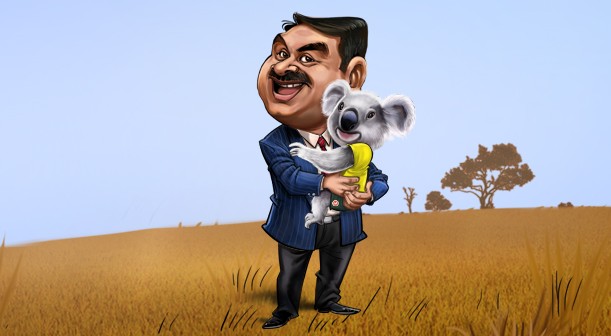India’s distinct model of globalisation is pegged on its commitment to greener growth economics.
Our cover in this issue featuring Adani Group Chairman Gautam Adani cuddling a koala bear is an ode to India’s distinct globalisation and development model. While it takes inspiration from the cover story on Adani’s $16.5-billion Carmichael coal mine-railroad-and-port project in Queensland, it also seeks to encapsulate the essence of Indo-Australian relations.
India and Australia have now moved beyond the traditional three Cs that characterised the relationship in the past – cricket, curry and Commonwealth. Although these three remain important markers of bilateral ties between the two nations, the clinch has grown tighter and now includes in its remit a much wider range of issues – trade, tourism, education, geo-strategy, energy security and a lot more.
Currently, Indian investments in Australia are touching the $12-billion mark, with an increasing number of Indian companies looking at Australia as an investment destination – a sign, perhaps, of the emerging Asian century. Much like the bond of friendship and support symbolised by the proverbial cuddle, India has in its dealings practiced building mutually sympathetic relationships as opposed to the slow strangle practiced by some of its rivals in their outbound FDI strategies. The cover theme thus seeks to capture this embracing quality of India’s foreign investment strategy based on values of cooperation, mutual respect and collaboration.
But why Australia? And why now?
India is Australia’s ninth-largest source of inbound tourists, with arrivals touching 260,000 in 2016, an increase of 11.3 per cent over the previous year. The forecast is for almost 500,000 Indian tourists to visit Australia in seven years. And here’s some trivia that I’m sure can liven up many an evening: Punjabi is the fastest-growing language in Australia and Hinduism the fastest-growing religion.
Australian Prime Minister Malcolm Turnbull’s visit to India last April delivered a range of outcomes in the knowledge, trade and strategic partnership spheres. Most important, he reassured India – after flip-flops on the issue by earlier Australian regimes – about uranium supplies that are key to India’s economic, energy and strategic concerns.
Also, India is Australia’s 10th-largest trading partner and that country is the second-most popular destination for Indian students – 60,000 Indians have gone to study in Australia in 2017 (till the end of August).
Despite the growing trade, strategic and people-to-people ties, however, serious challenges exist. India’s quest for resource and energy partnerships worldwide – primarily for raw materials such as coal and strategic minerals like uranium – means that the relationship with Australia will remain hostage to lobbies such as the ones opposing the Adani Group’s Carmichael project and those that are against the spread of nuclear energy.
Australian celebrities, such as cricketers Ian and Greg Chappel, joining the chorus against India’s largest outbound FDI deal – which is key to India’s energy security – skews the pitch a little more than expected. India has consistently honoured PM Modi’s commitment to greener growth economics at home and abroad and even provided global leadership in the area with the International Solar Alliance (ISA). A fact that has been ignored within the protest narrative around the Carmichael project. I am hopeful, however, that eventually both – India’s commitment to greener growth and the potential benefits to both Australia and India – will trump the naysayers in the end.
The India-Australia bilateral relationship may teeter on the brink at times – as the potential failure of the Adani investment to materialise may portend. I am confident, however, that this relationship has now attained a level of depth, breadth and maturity.
On a broader canvas, we have placed Adani’s Carmichael project in the context of India’s worldwide hunt for resources. Indian companies are scouring the farthest corners of the earth for raw materials and energy sources to feed its hungry factories back home. In that sense, India is following in the trajectory of Europe, the US and, most recently, China.
But there is one key difference in India’s approach – and our cover theme of a “koala cuddle” tells that story quite eloquently.







